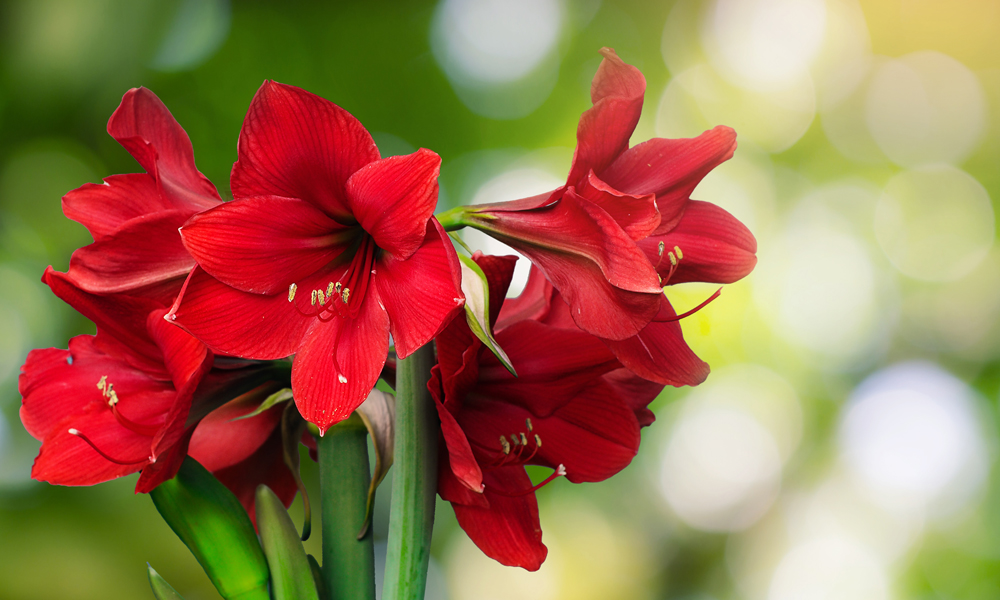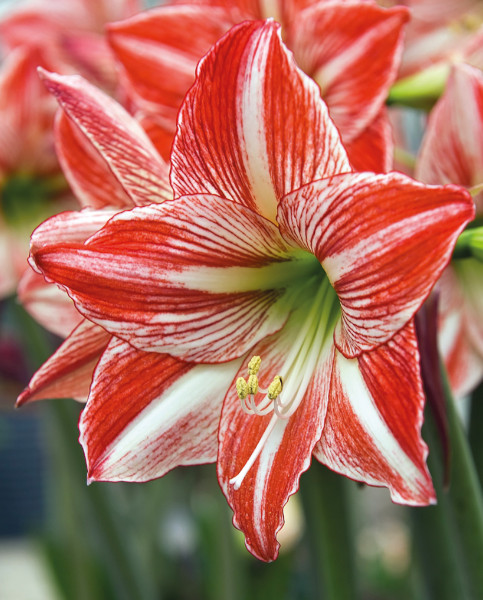How to grow Amaryllis
How to plant Amaryllis
While technically ‘amaryllis’ is the botanical name for a lesser known, frost hardy, South African bulb, it is (rather confusingly) also widely used in reference to hippeastrum – a tender Central and South American bulb popularly grown as a houseplant. This growing guide relates to the latter.
Amaryllis produces curving, trumpet-shaped blooms in winter and early spring. These can be big and flamboyant or fine and delicate depending on the variety. Unable to tolerate temperatures below 1°C it is usually grown as a houseplant in the UK, where the flowering season makes it a popular Christmas gift. Amaryllis bulbs can usually be expected to produce two stems (sometimes more, sometimes less), each bearing four to six flowers.

Key Information
Soil pH
Position
Hardiness


Where to plant Amaryllis
Amaryllis bulbs will flower around six to eight weeks after planting and can be planted any time from late September (to have them flowering for Christmas), to January.
Amaryllis are best grown in bright, undirect light. This might mean on a table set back from a sunny window, or on a windowsill that receives sun in the morning or afternoon (but not midday sun). Try to keep out of chilly drafts, and in a spot not too close to radiators or fires. A warm conservatory is another ideal position. You may need to rotate your amaryllis occasionally to prevent its stems bending towards the light.
Amaryllis are best planted in a well-drained of sand, loam or chalk within an acidic, alkaline or neutral PH balance. Amaryllis are well suited to pots and containers and should be kept indoors as they are tender, positioned in a conservatory where they are kept in a light and airy environment.
How to plant Amaryllis
Hand-waxed amaryllis bulbs require no potting and can simply be placed out in ‘naked’ form.
Loose amaryllis bulbs should be potted in tight-fitting containers (aim to have a space of no more than 1cm between the bulb and the edge of the container). Follow our easy step by step guide.
- Amaryllis can be grown singly, though for the biggest impact we recommend potting in groups of three.
- Choose an appropriate, snugly fitting container (see above), ensuring there are plenty of drainage holes in the bottom.
- Use a good quality potting compost with plenty of horticultural grit mixed in (aim for 40-50% grit), and, if not already present in the compost (check the description on the bag) some slow-release fertiliser granules.
- Plant the bulbs (pointy side up) so that they are close together but not touching. The top third of each bulb should stick out of the compost.
- Pick up the container and lightly tap on the potting bench or ground a few times to help settle the compost around the bulbs.
- Soak well with water.
- A mulch with horticultural grit will look attractive and help to prevent a ‘cap’ or crust forming on the top of the compost (something container plants can suffer due to the artificial nature of their watering).

What to plant with Amaryllis
While a pot (or three!) of amaryllis is more than capable of holding its own as an indoor display, like most plants it looks even better with a few neighbours. For this, nothing can beat succulents – those easy, year-round, and dare we say it ‘fool-proof’ indoor plants. Add some forced hyacinths and paperwhite daffodils (their bulbs specially treated to bloom around the same time as amaryllis), and your indoor space will be an envy-inducing, season-defying, floral extravaganza!
How to care for Amaryllis
Aftercare
Once your potted amaryllis has finished flowering, a few simple steps can be taken to ensure it blooms again next year.
- Snip off any spent flower stems close to the base but leave the leaves intact.
- The bulb will increase in size, so now is a good time to repot into a slightly larger pot.
- Continue to water as well as feeding with a liquid fertiliser, allowing the compost to dry out between soakings.
- Put your amaryllis outside during the warmer, summer months (this helps keep the bulbs and foliage healthy and disease free).
- Cease watering in August in order to trigger a dormant period. Expect the leaves to yellow and wither.
- In late September or early October, cut the foliage away, bring your amaryllis inside, and recommence watering. The bulbs should burst back into growth in time for a festive flowering display.
Hand-waxed amaryllis bulbs are intended to be grown for one year only. Dispose of these fuss-free versions after flowering, and start afresh each year.
Watering
Hand-waxed amaryllis bulbs require no watering, as the wax seals enough moisture in for one season’s growth.
Potted amaryllis bulbs should be watered sparingly until the foliage appears. After this, give a good soaking then allow the compost to dry out before giving another. Continue in this way until August. One of the biggest challenges faced by amaryllis is overwatering, which can cause yellow leaves and a droopy stem. Using a very gritty compost mix and following our watering advice should help avoid this issue.
Cold Protection
Amaryllis is a tender, subtropical plant best grown as a houseplant in our UK climate. Whilst it is coming into leaf, a temperature of around 21°C is ideal, and when in flower, a slightly cooler spot (say 15-20°C) will help to prolong the blooming period.
Pests and Diseases
Mosaic virus is a fungal infection that can affect bulbs such as amaryllis, showing as yellow streaks on the leaves and a gradually decreasing vigour.
Unfortunately, there is little to be done about this other than disposing of the bulb and starting again. Moving pots outside for the summer months can help to minimise the risk.
How to propagate Amaryllis
Amaryllis can be propagated using offsets – the small, ‘baby’ bulbs that form on the ‘mother’ bulb. These will become flowering bulbs which are identical to the parent in three to four years. The following process should be carried after flowering (so in January to March) when you are repotting the bulbs.
- Carefully remove the bulbs from their pots.
- Shake and rub off any compost.
- Gently tease away any offsets which have their own roots.
- Pot up the offsets into a gritty compost mix, and place in a warm, indoor spot in bright, indirect sunlight.
- Water as above.
- Feed with a liquid feed throughout summer.
- Don’t induce dormancy until bulbs reach flowering maturity.
Common questions about Amaryllis
- Can amaryllis grow outside?
These tender plants are rated H2, meaning they are unable to withstand temperatures dropping below the 5°C to 1°C range. We therefore recommend they be grown as houseplants in the UK, though you are advised to move them outside during the summer months to help ward off pests and diseases. - Will amaryllis grow in water?
Yes, you can grow amaryllis in special vases which allow the roots to reach the water but keep the bulb from touching it (this would cause rot). Check the water level every day and change it every week or so. The lack of nutrients will mean the bulbs can’t be reused in subsequent years, though it makes a beautiful, one-off display. - Will amaryllis grow back?
Hand-waxed amaryllis bulbs and those grown directly in water are intended for one growing season only. Amaryllis potted in compost can be encouraged to return year after year, following the simple steps above in ‘Aftercare’. - Can you grow amaryllis in shade?
This is not recommended, as it is likely to result in weak growth and poor flowering.




